Deep Learning in the Phase Extraction of Electronic Speckle Pattern Interferometry
Abstract
1. Introduction
- (1)
- The application of the existing deep learning methods for phase extraction in the field of ESPI is comprehensively analyzed and summarized. By comparing the performance of different methods and the potential advantages of deep learning compared with traditional methods, this paper provides readers with a comprehensive understanding and evaluation of this topic.
- (2)
- The development prospects of deep learning methods for phase extraction in the field of ESPI are explored. This paper discusses the possible challenges of current deep learning methods in ESPI phase extraction, and it proposes directions for future improvement and development to provide a reference for researchers.
- (3)
- This paper provides knowledge and guidance for scholars who want to use deep learning methods to measure ESPI strain and displacement in the future.
2. Production of ESPI Images
3. Application of Deep Learning in the Phase Extraction of ESPI Fringe Patterns
3.1. Application of Deep Learning in ESPI Fringe Pattern Filtering
- (1)
- Slow processing speed, rendering handling multiple frames simultaneously impossible.
- (2)
- Suboptimal denoising effect on complex images, such as high- and variable-density ESPI fringe patterns.
- (3)
- Poor generalization, necessitating repeated fine-tuning for various objects, and lack of a general model.
- (4)
- Substantial computational parameters.
3.2. Application of Deep Learning in the Fringe Skeleton Extraction Method
- (1)
- Low accuracy, poor generalization, slow extraction speed, and inability to process multiple frames simultaneously.
- (2)
- Poor extraction of damaged fringe patterns.
3.3. Application of Deep Learning in the Interpolation Algorithm
- (1)
- The interpolation result is not sufficiently accurate, and the resulting phase is not sufficiently smooth.
- (2)
- The quality requirements for the skeleton line are high.
- (3)
- Interpolation speed is slow.
4. Application of Deep Learning in Phase Extraction of the ESPI-Wrapped Phase Image
4.1. Application of Deep Learning in the Phase Shift Method
- (1)
- Conventional phase shifting requires the use of multiple images for phase extraction, whereas phase extraction based on a single fringe pattern exhibits lower accuracy. Balancing the two to achieve higher phase accuracy using fewer images remains challenging.
- (2)
- The process of time phase shifting requires the acquisition of multiple images, which requires considerable time and limits dynamic measurement.
4.2. Application of Deep Learning in ESPI-Wrapped Phase Image Filtering
- (1)
- Conventional filtering methods are time-consuming and require considerable parameter calculation.
- (2)
- Conventional methods have poor denoising capabilities for high-density and unevenly distributed phase maps.
4.3. Application of Deep Learning in the Phase Unwrapping Algorithm
4.3.1. Unwrapping Algorithm Based on Image Segmentation
4.3.2. One-Step Direct Unwrapping Algorithm
5. Summary and Outlook
- (1)
- Integration of the physical model into the deep learning model.
- (2)
- Improvement and optimization of deep learning models.
- (3)
- Quantitative evaluation of phase extraction quality.
- (4)
- Limited practical engineering applications.
- (5)
- Expanding the dataset.
Author Contributions
Funding
Data Availability Statement
Acknowledgments
Conflicts of Interest
References
- Vaz, B.F.; Ferracini, E.; Santos, A.A.; Gonçalves, R. Measuring stress fields in connecting rods using laser interferometry (ESPI). J. Test. Eval. 2015, 43, 735–748. [Google Scholar] [CrossRef]
- Martínez, A.; Rayas, J.A.; Rodríguez-Vera, R.; Puga, H.J. Three-dimensional deformation measurement from the combination of in-plane and out-of-plane electronic speckle pattern interferometers. Appl. Opt. 2004, 43, 4652–4658. [Google Scholar] [CrossRef] [PubMed]
- Nitta, I.; Sato, T.; Tsukiyama, Y. 3D surface profile measurement by single shot interferometry with wide field of view. In Proceedings of the Asian Conference on Experimental Mechanics, Niigata City, Japan, 7–10 October 2019. [Google Scholar]
- Kumar, M.; Gaur, K.K.; Shakher, C. Measurement of material constants (Young’s modulus and Poisson’s ratio) of polypropylene using digital speckle pattern interferometry (DSPI). J. Jpn. Soc. Exp. Mech. 2015, 15, s87–s91. [Google Scholar]
- Kennedy, D.M.; Schauperl, Z.; Greene, S. Application of ESPI-method for strain analysis in thin wall cylinders. Opt. Lasers Eng. 2004, 41, 585–594. [Google Scholar] [CrossRef]
- Labbe, F. Strain-rate measurements by electronic speckle-pattern interferometry (ESPI). Opt. Lasers Eng. 2007, 45, 827–833. [Google Scholar] [CrossRef]
- Loukil, M.S.; Ayadi, Z.; Varna, J. ESPI analysis of crack face displacements in damaged laminates. Compos. Sci. Technol. 2014, 94, 80–88. [Google Scholar] [CrossRef]
- Yang, L.; Xie, X.; Zhu, L.; Wu, S.; Wang, Y. Review of electronic speckle pattern interferometry (ESPI) for three dimensional displacement measurement. Chin. J. Mech. Eng. 2014, 27, 1–13. [Google Scholar] [CrossRef]
- Shuhai, J.; Kaiduan, Y.; Yushan, T. The system of double-optical-path ESPI for the vibration measurement. Opt. Lasers Eng. 2000, 34, 67–74. [Google Scholar] [CrossRef]
- Farrant, D.I.; Petzing, J.N.; Tyrer, J.R. Geometrically qualified ESPI vibration analysis of an engine. Opt. Lasers Eng. 2004, 41, 659–671. [Google Scholar] [CrossRef]
- Li, X.; Sung, P.; Patterson, E.; Wang, W.; Christian, W. Identification of defects in composite laminates by comparison of mode shapes from electronic speckle pattern interferometry. Opt. Lasers Eng. 2023, 163, 107444. [Google Scholar] [CrossRef]
- Ferretti, D.; Rossi, M.; Royer-Carfagni, G. An ESPI experimental study on the phenomenon of fracture in glass. Is it brittle or plastic? J. Mech. Phys. Solids 2011, 59, 1338–1354. [Google Scholar] [CrossRef]
- Wang, K.; Song, L.; Wang, C.; Ren, Z.; Zhao, G.; Dou, J.; Di, J.; Barbastathis, G.; Zhou, R.; Zhao, J.; et al. On the use of deep learning for phase recovery. Light Sci. Appl. 2024, 13, 4. [Google Scholar] [CrossRef] [PubMed]
- Zuo, C.; Feng, S.; Huang, L.; Tao, T.; Yin, W.; Chen, Q. Phase shifting algorithms for fringe projection profilometry: A review. Opt. Lasers Eng. 2018, 109, 23–59. [Google Scholar] [CrossRef]
- de Groot, P. Phase-shift calibration errors in interferometers with spherical Fizeau cavities. Appl. Opt. 1995, 34, 2856–2863. [Google Scholar] [CrossRef] [PubMed]
- LeCun, Y.; Bengio, Y.; Hinton, G. Deep learning. Nature 2015, 521, 436–444. [Google Scholar] [CrossRef] [PubMed]
- Zuo, C.; Qian, J.; Feng, S.; Yin, W.; Li, Y.; Fan, P.; Han, J.; Qian, K.; Chen, Q. Deep learning in optical metrology: A review. Light Sci. Appl. 2022, 11, 39. [Google Scholar] [CrossRef] [PubMed]
- Archbold, E.; Burch, J.M.; Ennos, A.E.; Taylor, P.A. Visual observation of surface vibration nodal patterns. Nature 1969, 222, 263–265. [Google Scholar] [CrossRef]
- Chen, M. Research and Application of A New Method for Phase Extraction in Electronic Speckle Interferometry Based on Machine Learning. Ph.D. Thesis, Tianjin University, Tianjin, China, 2020. (In Chinese). [Google Scholar]
- Tang, C.; Han, L.; Ren, H.; Zhou, D.; Chang, Y.; Wang, X.; Cui, X. Second-order oriented partial-differential equations for denoising in electronic-speckle-pattern interferometry fringes. Opt. Lett. 2008, 33, 2179–2181. [Google Scholar] [CrossRef]
- Zhang, K.; Zuo, W.; Zhang, L. FFDNet: Toward a fast and flexible solution for CNN-based image denoising. IEEE Trans. Image Process. 2018, 27, 4608–4622. [Google Scholar] [CrossRef]
- Hao, F.; Tang, C.; Xu, M.; Lei, Z. Batch denoising of ESPI fringe patterns based on convolutional neural network. Appl. Opt. 2019, 58, 3338–3346. [Google Scholar] [CrossRef]
- Lin, B.; Fu, S.; Zhang, C.; Wang, F.; Li, Y. Optical fringe patterns filtering based on multi-stage convolution neural network. Opt. Lasers Eng. 2020, 126, 105853. [Google Scholar] [CrossRef]
- Wang, L.; Li, R.; Tian, F.; Fang, X. Application of attention-DnCNN for ESPI fringe patterns denoising. J. Opt. Soc. Am. A Opt. Image Sci. Vis. 2022, 39, 2110–2123. [Google Scholar] [CrossRef] [PubMed]
- Xu, M.; Tang, C.; Hong, N.; Lei, Z. MDD-Net: A generalized network for speckle removal with structure protection and shape preservation for various kinds of ESPI fringe patterns. Opt. Lasers Eng. 2022, 154, 107017. [Google Scholar] [CrossRef]
- Gurrola-Ramos, J.; Dalmau, O.; Alarcon, T. U-Net based neural network for fringe pattern denoising. Opt. Lasers Eng. 2022, 149, 106829. [Google Scholar] [CrossRef]
- Lam, L.; Lee, S.W.; Suen, C.Y. Thinning methodologies a comprehensive survey. IEEE Trans. Pattern Anal. Mach. Intell. 1992, 14, 869–885. [Google Scholar] [CrossRef]
- Quan, C.; Tay, C.J.; Yang, F.; He, X. Phase extraction from a single fringe pattern based on guidance of an extreme map. Appl. Opt. 2005, 44, 4814–4821. [Google Scholar] [CrossRef] [PubMed]
- Tang, C.; Lu, W.; Cai, Y.; Han, L.; Wang, G. Nearly preprocessing-free method for skeletonization of gray-scale electronic speckle pattern interferometry fringe patterns via partial differential equations. Opt. Lett. 2008, 33, 183–185. [Google Scholar] [CrossRef]
- Tang, C.; Ren, H.; Wang, L.; Wang, Z.; Han, L.; Gao, T. Oriented couple gradient vector fields for skeletonization of gray-scale optical fringe patterns with high density. Appl. Opt. 2010, 49, 2979–2984. [Google Scholar] [CrossRef]
- Zhang, F.; Wang, D.; Xiao, Z.; Geng, L.; Wu, J.; Xu, Z.; Sun, J.; Wang, J.; Xi, J. Skeleton extraction and phase interpolation for single ESPI fringe pattern based on the partial differential equations. Opt. Express 2015, 23, 29625–29638. [Google Scholar] [CrossRef]
- Chen, X.; Tang, C.; Li, B.; Su, Y. Gradient vector fields based on variational image decomposition for skeletonization of electronic speckle pattern interferometry fringe patterns with variable density and their applications. Appl. Opt. 2016, 55, 6893–6902. [Google Scholar] [CrossRef]
- Li, B.; Tang, C.; Zheng, T.; Lei, Z. Fully automated extraction of the fringe skeletons in dynamic electronic speckle pattern interferometry using a U-Net convolutional neural network. Opt. Eng. 2019, 58, 023105. [Google Scholar] [CrossRef]
- Li, B.; Li, Z.; Zhang, J.; Sun, G.; Mei, J.; Yan, J. Channel transformer U-Net: An automatic and effective skeleton extraction network for electronic speckle pattern interferometry. Appl. Opt. 2023, 62, 325–334. [Google Scholar] [CrossRef] [PubMed]
- Liu, C.; Tang, C.; Xu, M.; Hao, F.; Lei, Z. Skeleton extraction and inpainting from poor, broken ESPI fringe with an M-net convolutional neural network. Appl. Opt. 2020, 59, 5300–5308. [Google Scholar] [CrossRef] [PubMed]
- Wang, H.; Zhang, Z.; Zhu, Q.; Wang, X.; Dong, Z.; Men, G.; Wang, J.; Lei, J.; Wang, W. Batch skeleton extraction from ESPI fringe patterns using pix2pix conditional generative adversarial network. Opt. Rev. 2022, 29, 97–105. [Google Scholar] [CrossRef]
- Isola, P.; Zhu, J.Y.; Zhou, T.; Efros, A.A. Image-to-image translation with conditional adversarial networks. In Proceedings of the 2017 IEEE Conference on Computer Vision and Pattern Recognition (CVPR), Honolulu, HI, USA, 21–27 July 2017; pp. 5967–5976. [Google Scholar]
- Parker, J.A.; Kenyon, R.V.; Troxel, D.E. Comparison of interpolating methods for image resampling. IEEE Trans. Med. Imaging 1983, 2, 31–39. [Google Scholar] [CrossRef] [PubMed]
- Lehmann, T.M.; Gonner, C.; Spitzer, K. Survey: Interpolation methods in medical image processing. IEEE Trans. Med. Imaging 1999, 18, 1049–1075. [Google Scholar] [CrossRef] [PubMed]
- Maeland, E. On the comparison of interpolation methods. IEEE Trans. Med. Imaging 1988, 7, 213–217. [Google Scholar] [CrossRef]
- Tang, C.; Lu, W.; Chen, S.; Zhang, Z.; Li, B.; Wang, W.; Han, L. Denoising by coupled partial differential equations and extracting phase by backpropagation neural networks for electronic speckle pattern interferometry. Appl. Opt. 2007, 46, 7475–7484. [Google Scholar] [CrossRef]
- Wang, G.; Li, Y.J.; Zhou, H.C. Application of the radial basis function interpolation to phase extraction from a single electronic speckle pattern interferometric fringe. Appl. Opt. 2011, 50, 3110–3117. [Google Scholar] [CrossRef]
- Huang, P.S.; Zhang, S. Fast three-step phase-shifting algorithm. Appl. Opt. 2006, 45, 5086–5091. [Google Scholar] [CrossRef]
- Schwider, J.; Falkenstoerfer, O.R.; Schreiber, H.; Zoeller, A.; Streibl, N. New compensating four-phase algorithm for phase-shift interferometry. Opt. Eng. 1993, 32, 1883–1885. [Google Scholar] [CrossRef]
- Novak, J. Five-step phase-shifting algorithms with unknown values of phase shift. Optik 2003, 114, 63–68. [Google Scholar] [CrossRef]
- Ponslet, E.; Steinzig, M. Residual stress measurement using the hole drilling method and laser speckle interferometry part III: Analysis technique. Exp. Tech. 2003, 27, 45–48. [Google Scholar] [CrossRef]
- Bi, H.; Zhang, Y.; Ling, K.V.; Wen, C. Class of 4 + 1-phase algorithms with error compensation. Appl. Opt. 2004, 43, 4199–4207. [Google Scholar] [CrossRef] [PubMed]
- Feng, S.; Chen, Q.; Gu, G.; Tao, T.; Zhang, L.; Hu, Y.; Yin, W.; Zuo, C. Fringe pattern analysis using deep learning. Adv. Photonics 2019, 1, 025001. [Google Scholar] [CrossRef]
- Zhang, Q.; Lu, S.; Li, J.; Li, D.; Lu, X.; Zhong, L.; Tian, J. Phase-shifting interferometry from single frame in-line interferogram using deep learning phase-shifting technology. Opt. Commun. 2021, 498, 127226. [Google Scholar] [CrossRef]
- Yan, K.; Yu, Y.; Sun, T.; Asundi, A.; Kemao, Q. Wrapped phase denoising using convolutional neural networks. Opt. Lasers Eng. 2020, 128, 105999. [Google Scholar] [CrossRef]
- Li, J.; Tang, C.; Xu, M.; Fan, Z.; Lei, Z. DBDNet for denoising in ESPI wrapped phase patterns with high density and high speckle noise. Appl. Opt. 2021, 60, 10070–10079. [Google Scholar] [CrossRef]
- Li, J.; Tang, C.; Xu, M.; Lei, Z. Uneven wrapped phase pattern denoising using a deep neural network. Appl. Opt. 2022, 61, 7150–7157. [Google Scholar] [CrossRef]
- Spoorthi, G.E.; Gorthi, S.; Gorthi RK, S.S. PhaseNet: A deep convolutional neural network for two-dimensional phase unwraping. IEEE Signal Process. Lett. 2018, 26, 54–58. [Google Scholar] [CrossRef]
- Spoorthi, G.E.; Gorthi RK, S.S.; Gorthi, S. PhaseNet 2.0: Phase unwrapping of noisy data based on deep learning approach. IEEE Trans. Image Process. 2020, 29, 4862–4872. [Google Scholar] [CrossRef]
- Zhang, T.; Jiang, S.; Zhao, Z.; Dixit, K.; Zhou, X.; Hou, J.; Zhang, Y.; Yan, C. Rapid and robust two-dimensional phase unwrapping via deep learning. Opt. Express 2019, 27, 23173–23185. [Google Scholar] [CrossRef] [PubMed]
- Zhang, J.; Tian, X.; Shao, J.; Luo, H.; Liang, R. Phase unwrapping in optical metrology via denoised and convolutional segmentation networks. Opt. Express 2019, 27, 14903–14912. [Google Scholar] [CrossRef] [PubMed]
- Wang, K.; Li, Y.; Kemao, Q.; Di, J.; Zhao, J. One-step robust deep learning phase unwrapping. Opt. Express 2019, 27, 15100–15115. [Google Scholar] [CrossRef]
- Qin, Y.; Wan, S.; Wan, Y.; Weng, J.; Liu, W.; Gong, Q. Direct and accurate phase unwrapping with deep neural network. Appl. Opt. 2020, 59, 7258–7267. [Google Scholar] [CrossRef]
- Xu, M.; Tang, C.; Shen, Y.; Hong, N.; Lei, Z. PU-M-Net for phase unwrapping with speckle reduction and structure protection in ESPI. Opt. Lasers Eng. 2022, 151, 106824. [Google Scholar] [CrossRef]
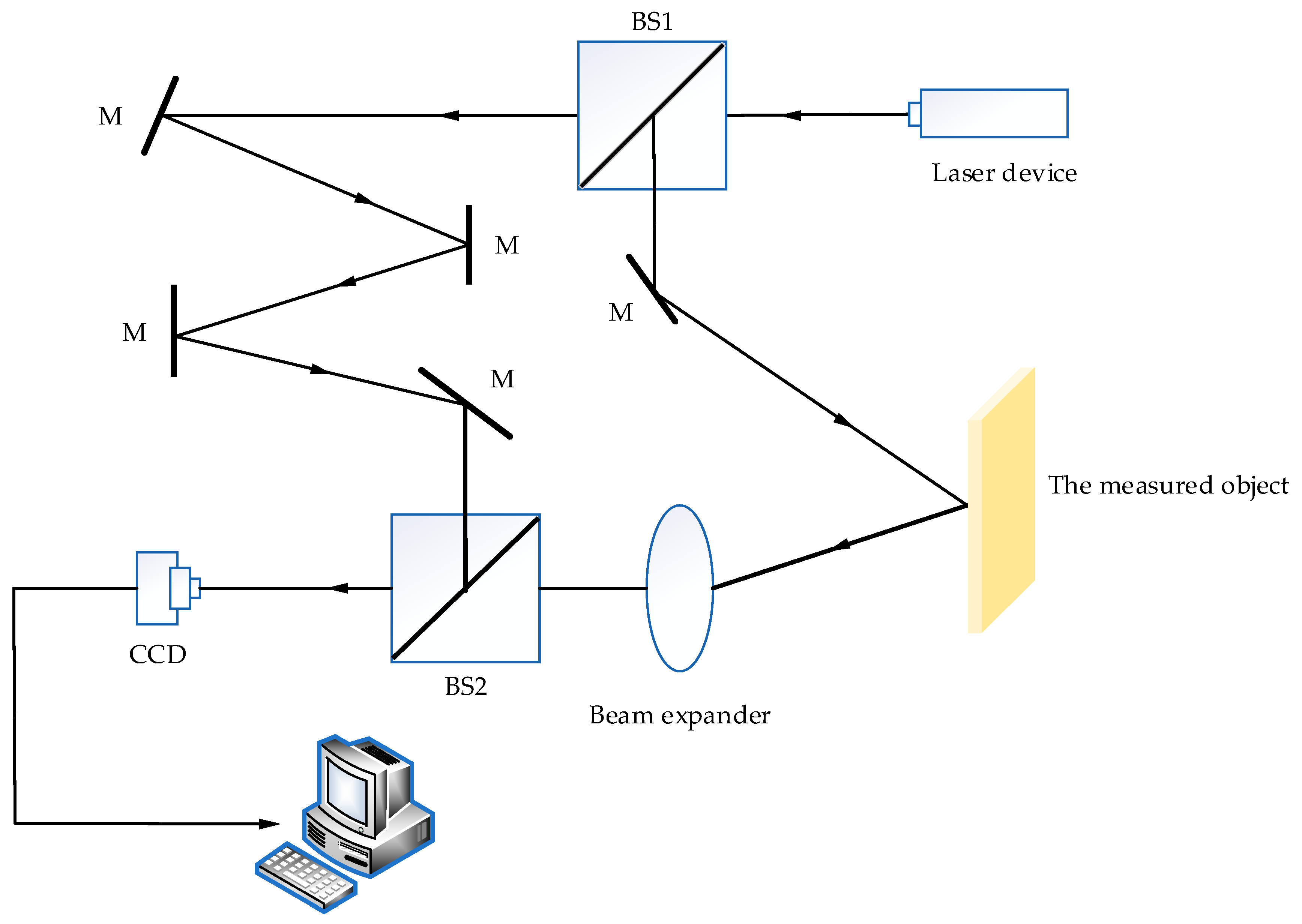

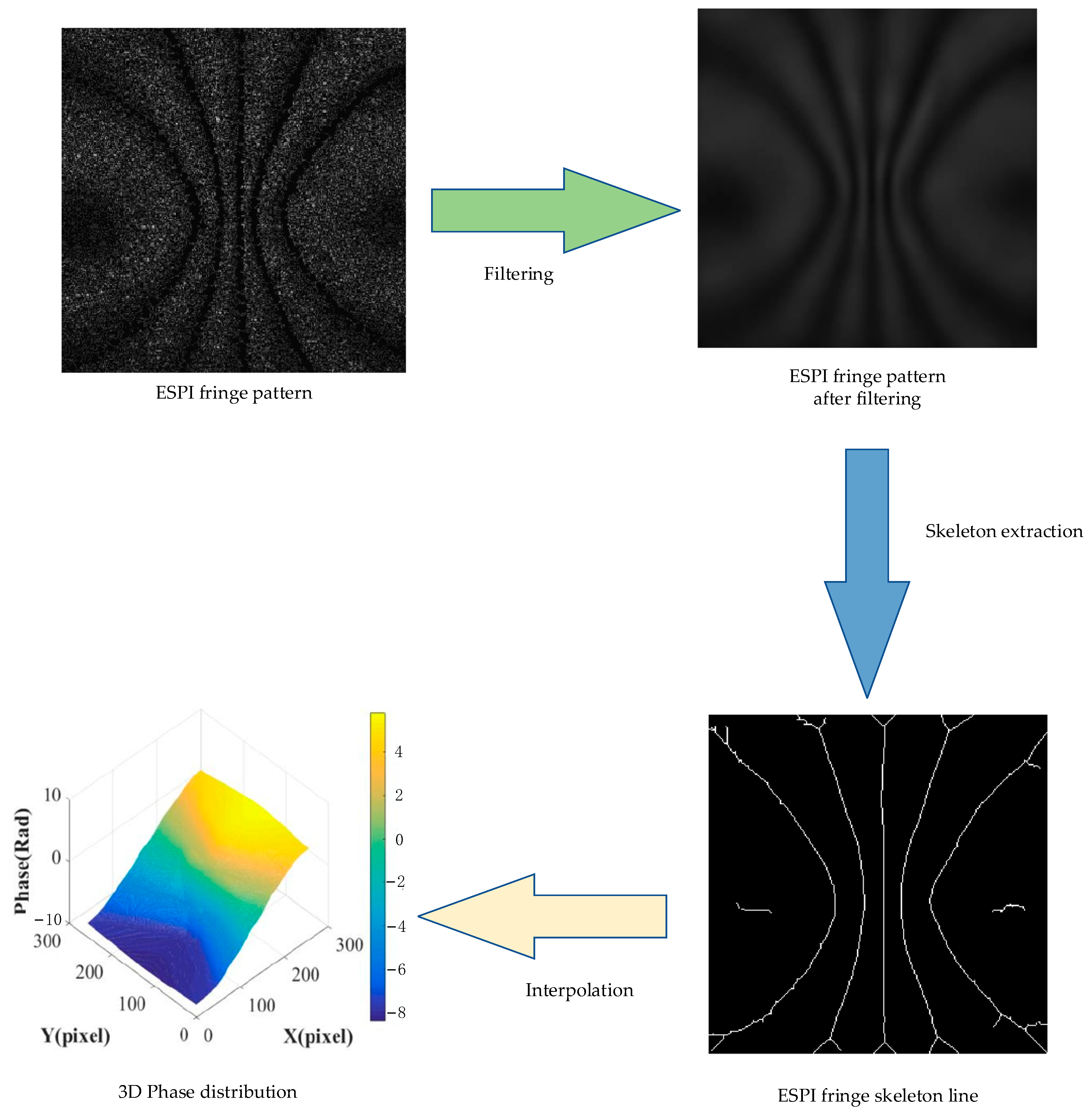

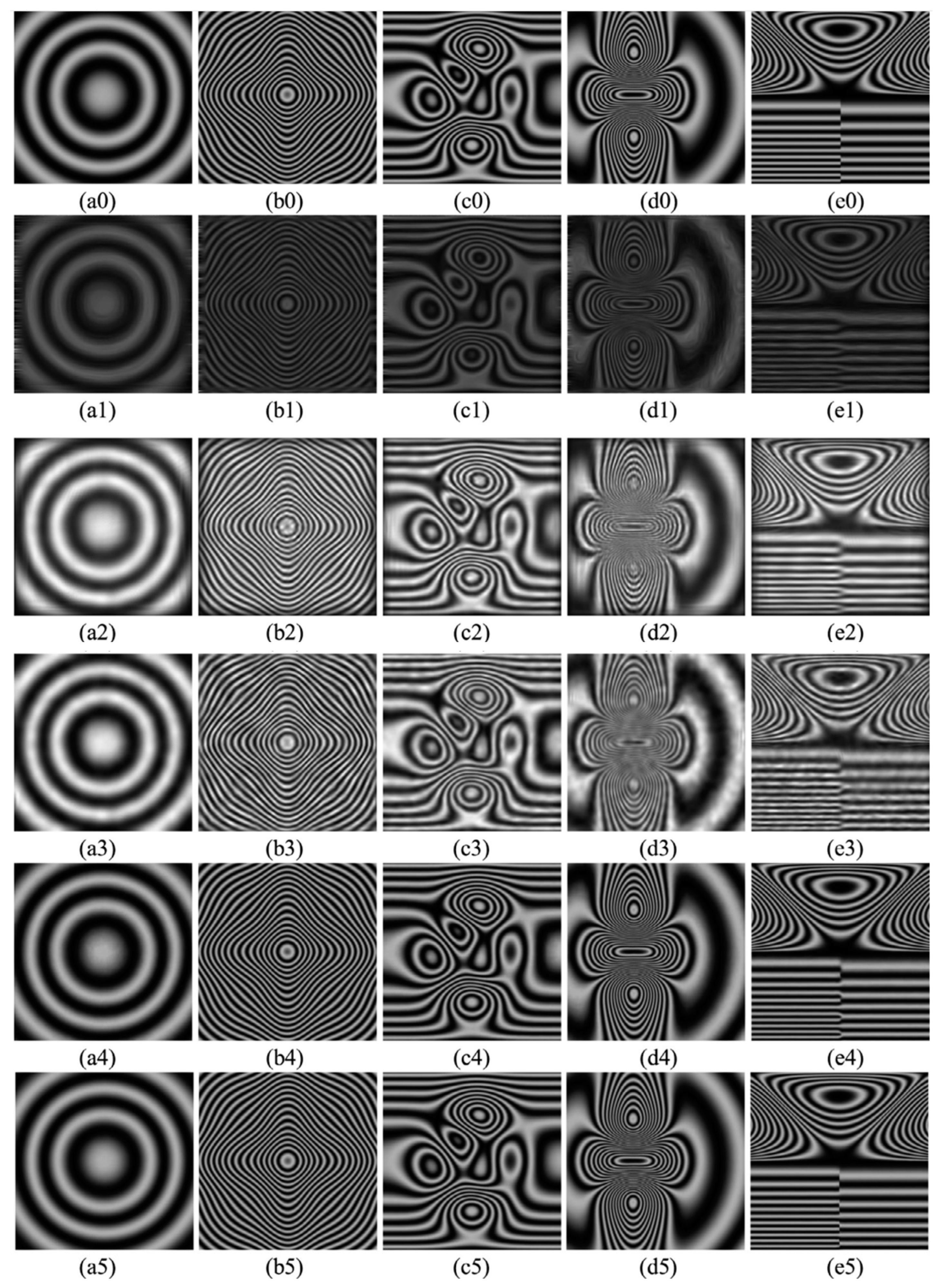
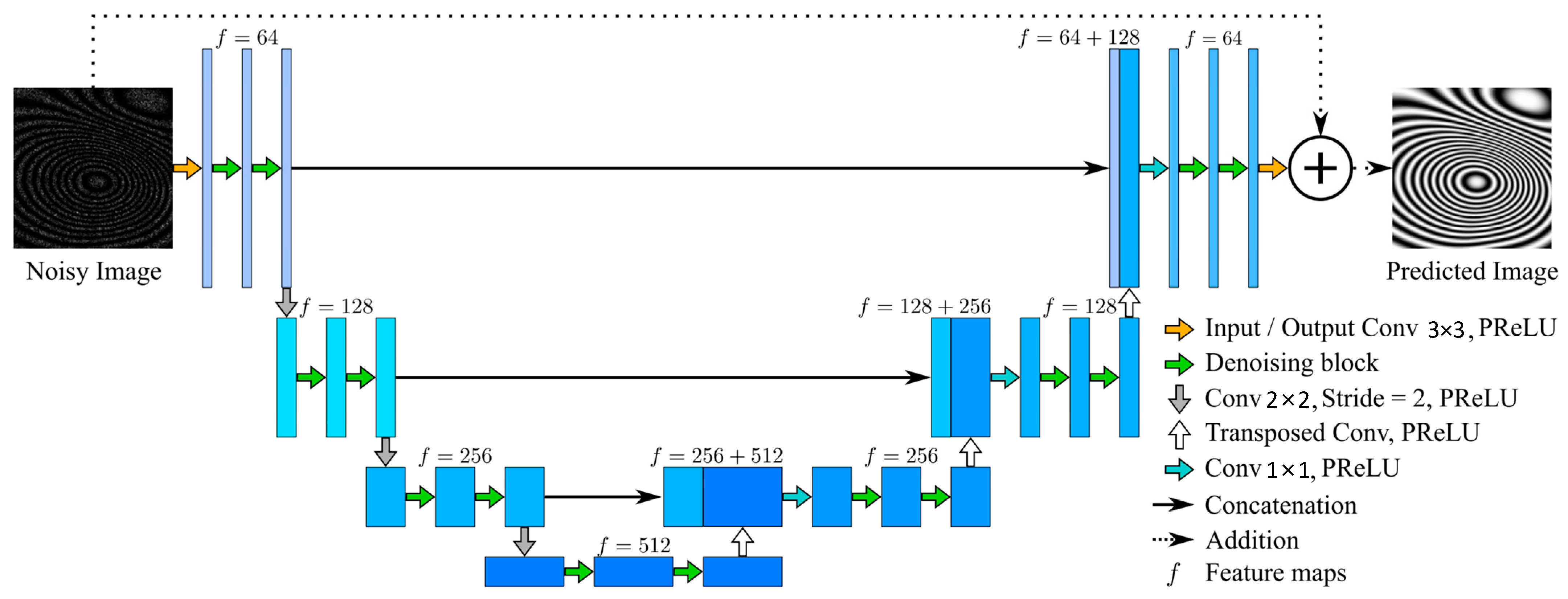



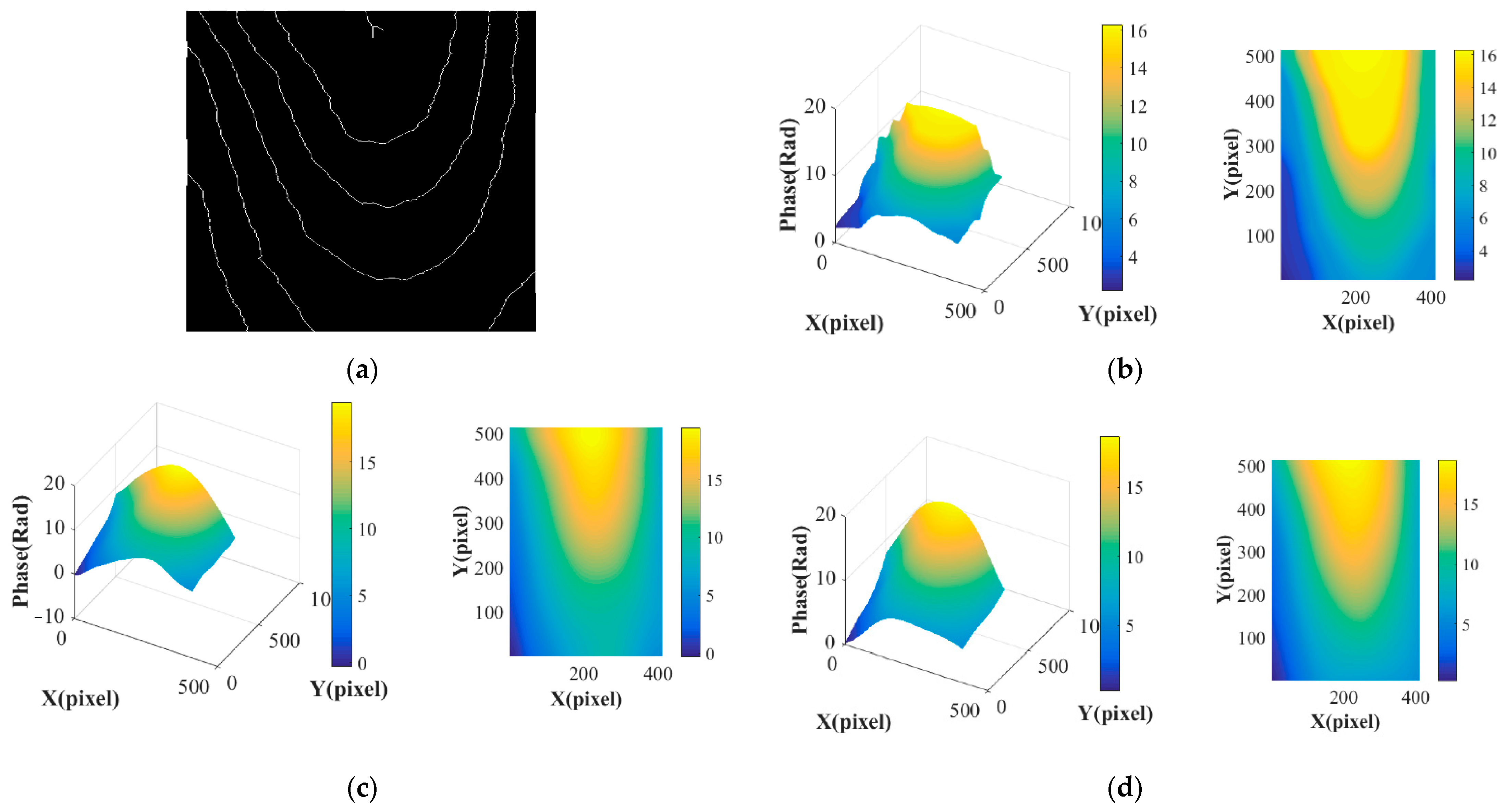
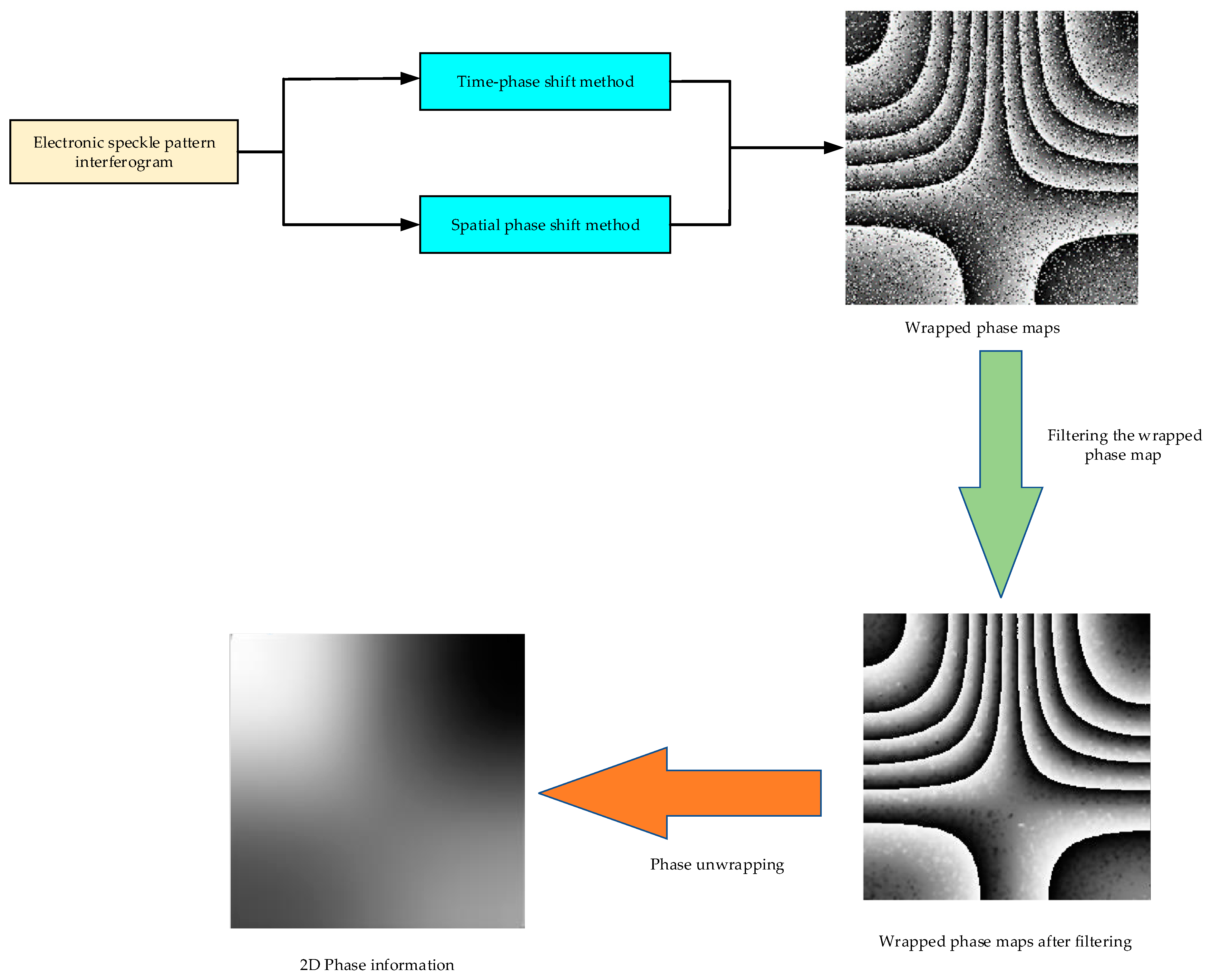
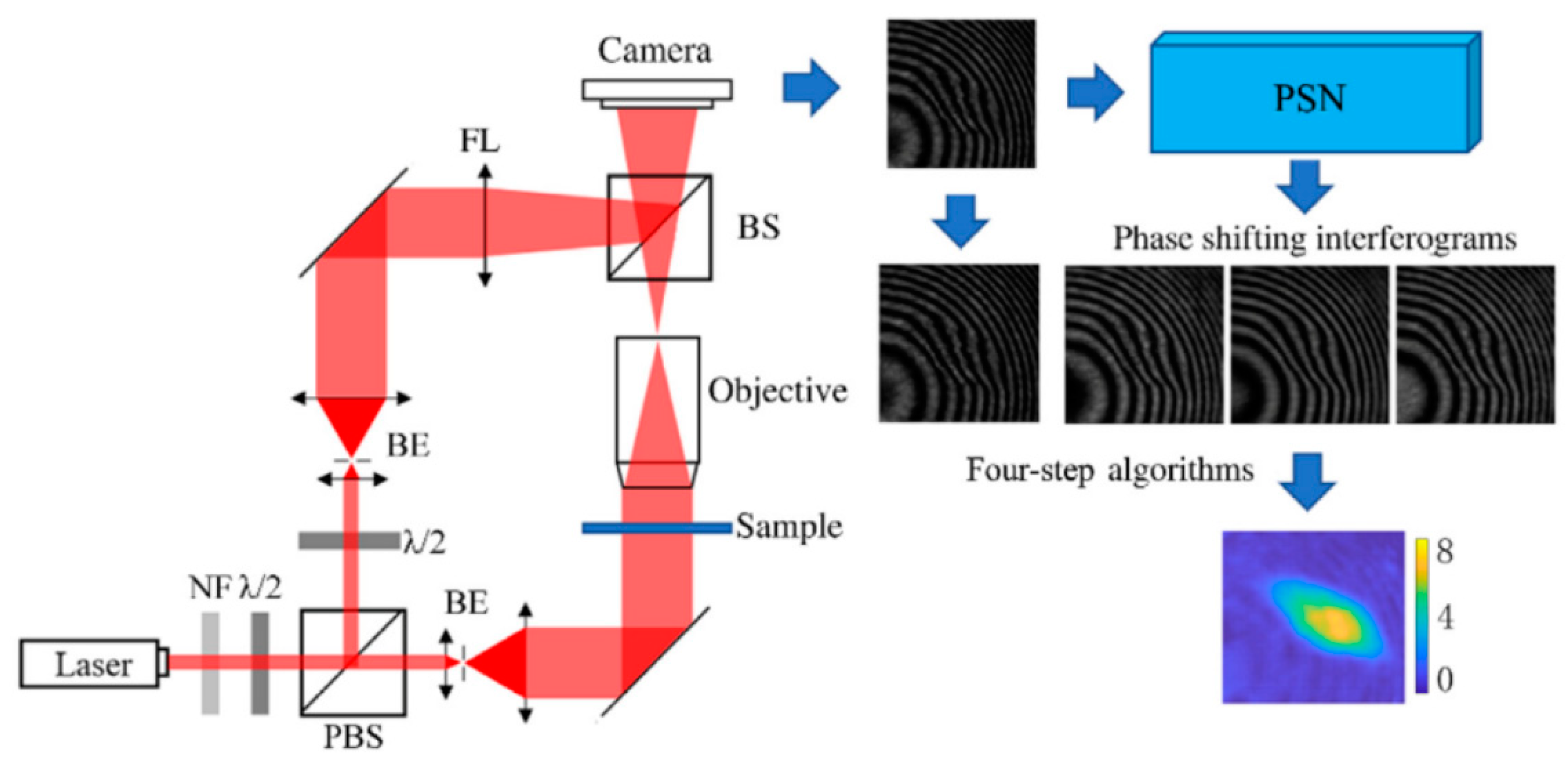
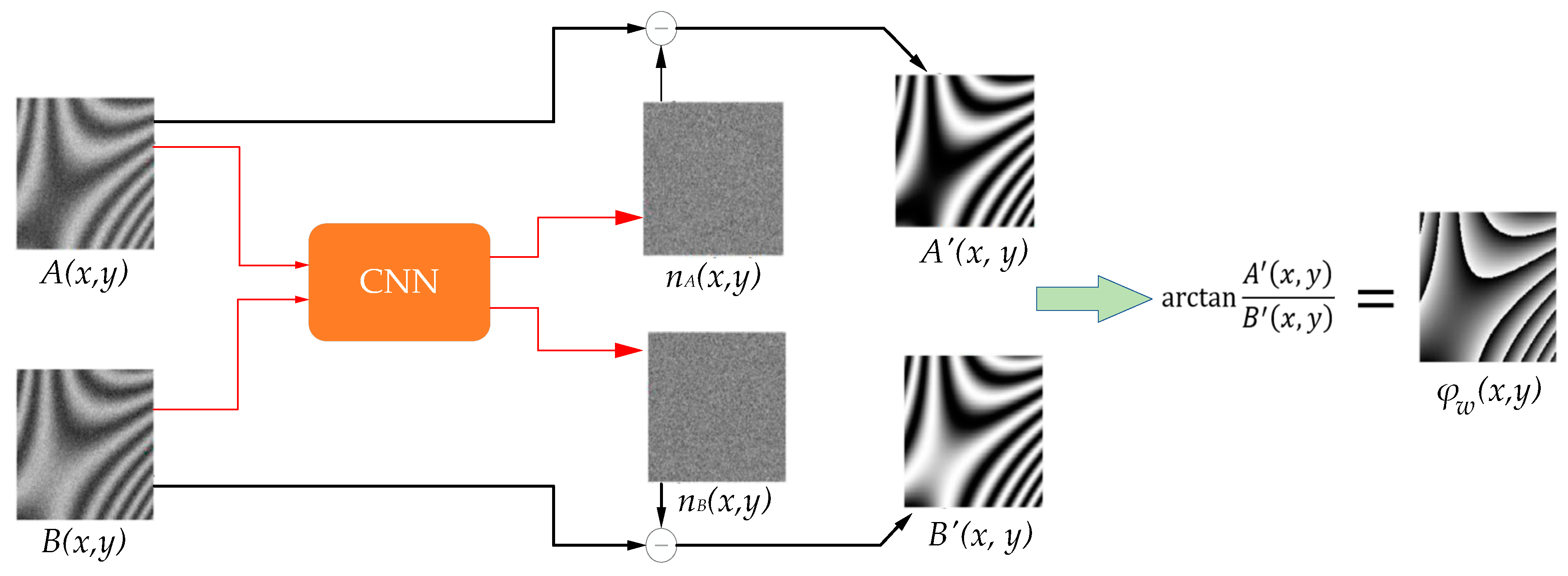
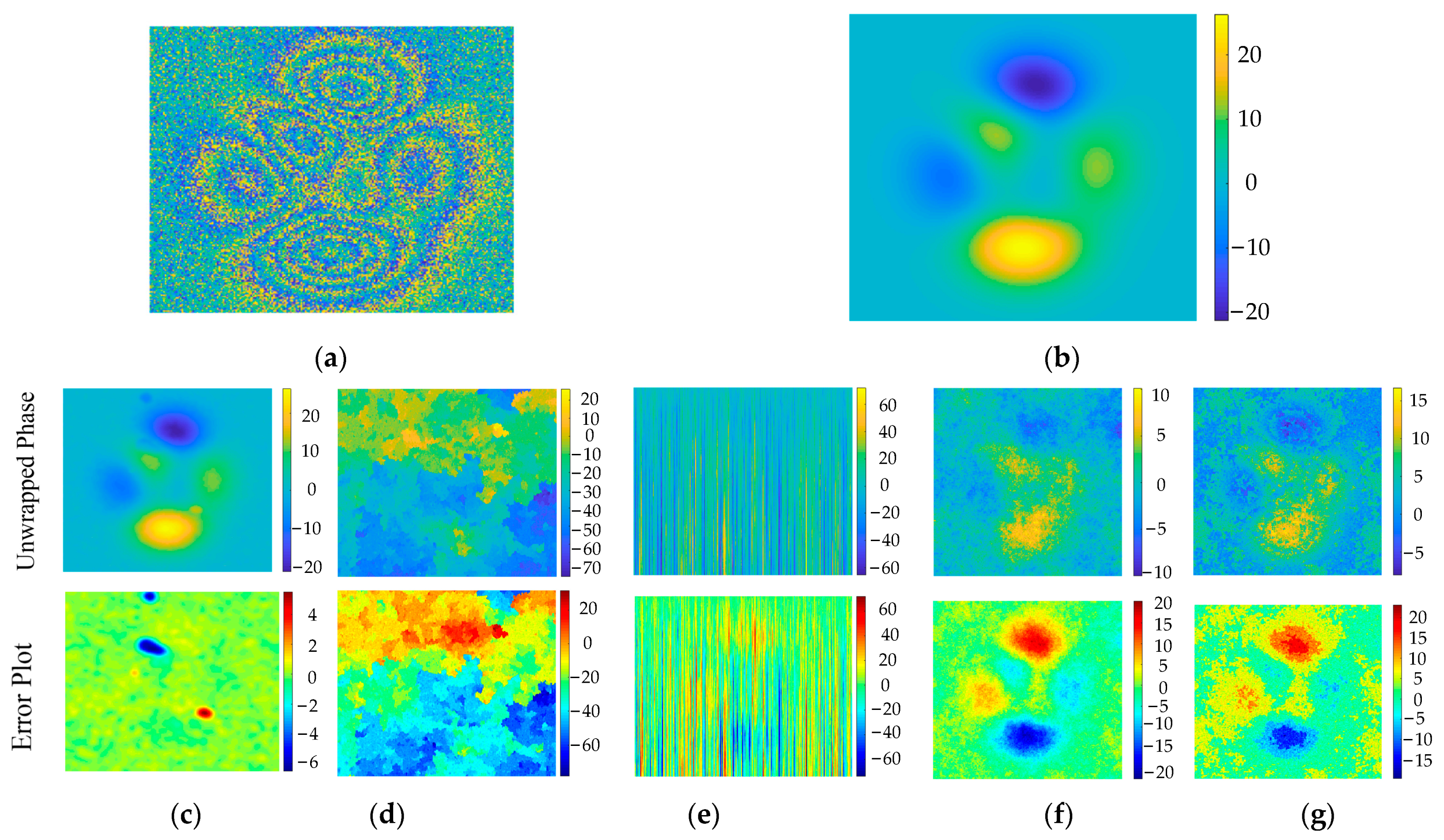
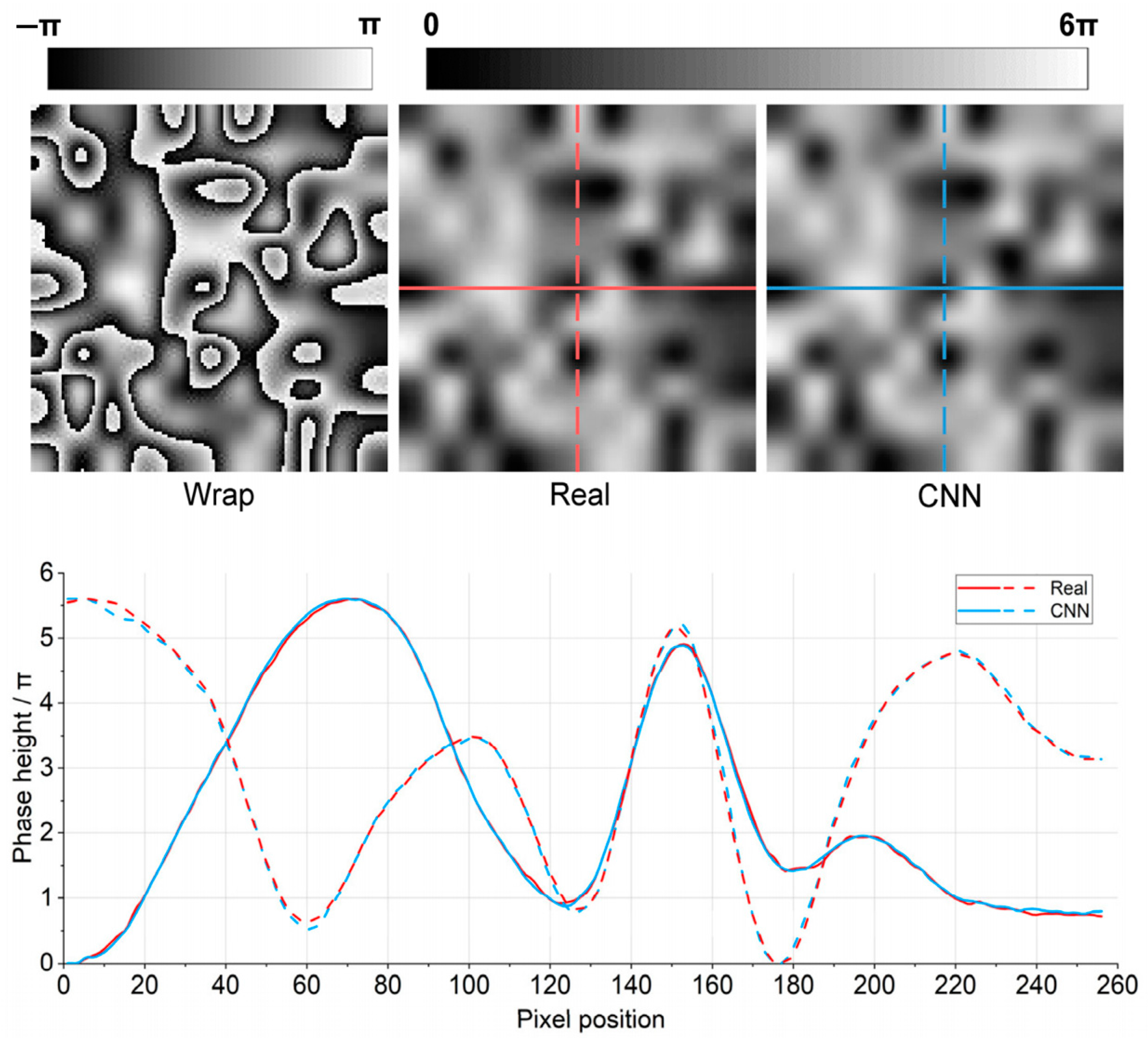
| Performance Indicators | FFD-Net [21] | AD-CNN [24] | FPD-CNN [23] | MDD-Net [25] | LRDUNet [26] |
|---|---|---|---|---|---|
| PSNR (dB) | 35.2269 | 25.0397 | 27.88 | / | 40.1427 |
| SSIM | 0.9932 | 0.9487 | 0.972 | 0.991 | 0.9980 |
| MAE | 0.0117 | / | 0.0135 | / | 0.0067 |
| Parameters (M) | 0.475 | / | 1.86 | 1.445 | 4.21 |
| Running time (s) | 0.024 | 0.0469 | 0.57 | 0.041 | 0.00665 |
| Methods | Acc | Sensitivity | Specificity | F1 | CC | Running Time(s) |
|---|---|---|---|---|---|---|
| D-GVF [32] | / | / | / | / | 0.9775 | / |
| U-net [33] | 0.9133 | 0.6884 | 0.8621 | 0.6254 | 0.9408 | 0.5 |
| CTrans U-net [34] | 0.9878 | 0.8890 | 0.9887 | 0.8881 | 0.9905 | / |
| M-Net [35] | 0.9571 | 0.7412 | 0.9411 | 0.7411 | 0.9521 | / |
| Pix2pix cGan [36] | 0.9704 | / | / | 0.8174 | 0.8633 | 11.7 |
| Research Studies | Method | Proposed Solution | Advantages | Disadvantages |
|---|---|---|---|---|
| Yao et al. [50] | Improved ResNet | Solves the problem of false phase jumps. | Excellent noise reduction performance; solves the problem of false phase jumps. | The model calculation parameters are too large. |
| Li et al. [51] | DBDNet | Solves the problem of phase denoising for large model calculation parameters and high-density and high-speckle noise. | Small number of model parameters; strong ability to recognize details. | Poor ability to obtain more comprehensive phase information. |
| Li et al. [52] | DBDNet2 | Solves the problem of poor denoising ability for high-density noise uneven phase maps. | Excellent denoising performance and strong feature extraction ability. | May not be versatile. |
| Method | Advantages | Disadvantages |
|---|---|---|
| Conventional filtering method | The physical model has strong interpretability; it does not require a large amount of training data; and some algorithms are relatively simple. | Rely on accurate physical models; sensitive to parameter adjustments; unable to handle multiple objects simultaneously. |
| Filtering method based on deep learning | Strong adaptability; no parameter tuning is required after network training; batch processing is possible. | The demand for a large amount of labeled data; poor interpretability. |
| Researchers | Get Phases Directly | SSIM | MSE | RMSE | Advantages | Disadvantages |
|---|---|---|---|---|---|---|
| G.E.Spoorthi et al. [53] | No | / | 2 | / | High accuracy | Requires post-processing |
| G.E.Spoorthi et al. [54] | No | / | / | / | High accuracy | Lack of comparison with similar methods |
| Zhang et al. [55] | No | / | 1.5608 | 1.2325 | High accuracy | There is a significant error in high-speckle conditions |
| Zhang et al. [56] | No | / | / | 0.0027 | It can identify phase discontinuity | Requires pre- and post-processing |
| Wang et al. [57] | Yes | 0.991 | 3.150 | / | Directly obtain phase and high accuracy | Limited dynamic range, and the effect at phase jump points still needs to be improved |
| Qin et al. [58] | Yes | 0.816 | 1.737 | / | Excellent performance | Significantly increases training costs |
| Xu et al. [59] | Yes | 0.810 | 1.673 | / | High computational efficiency | Lack of generalization analysis |
Disclaimer/Publisher’s Note: The statements, opinions and data contained in all publications are solely those of the individual author(s) and contributor(s) and not of MDPI and/or the editor(s). MDPI and/or the editor(s) disclaim responsibility for any injury to people or property resulting from any ideas, methods, instructions or products referred to in the content. |
© 2024 by the authors. Licensee MDPI, Basel, Switzerland. This article is an open access article distributed under the terms and conditions of the Creative Commons Attribution (CC BY) license (https://creativecommons.org/licenses/by/4.0/).
Share and Cite
Jiang, W.; Ren, T.; Fu, Q. Deep Learning in the Phase Extraction of Electronic Speckle Pattern Interferometry. Electronics 2024, 13, 418. https://doi.org/10.3390/electronics13020418
Jiang W, Ren T, Fu Q. Deep Learning in the Phase Extraction of Electronic Speckle Pattern Interferometry. Electronics. 2024; 13(2):418. https://doi.org/10.3390/electronics13020418
Chicago/Turabian StyleJiang, Wenbo, Tong Ren, and Qianhua Fu. 2024. "Deep Learning in the Phase Extraction of Electronic Speckle Pattern Interferometry" Electronics 13, no. 2: 418. https://doi.org/10.3390/electronics13020418
APA StyleJiang, W., Ren, T., & Fu, Q. (2024). Deep Learning in the Phase Extraction of Electronic Speckle Pattern Interferometry. Electronics, 13(2), 418. https://doi.org/10.3390/electronics13020418








